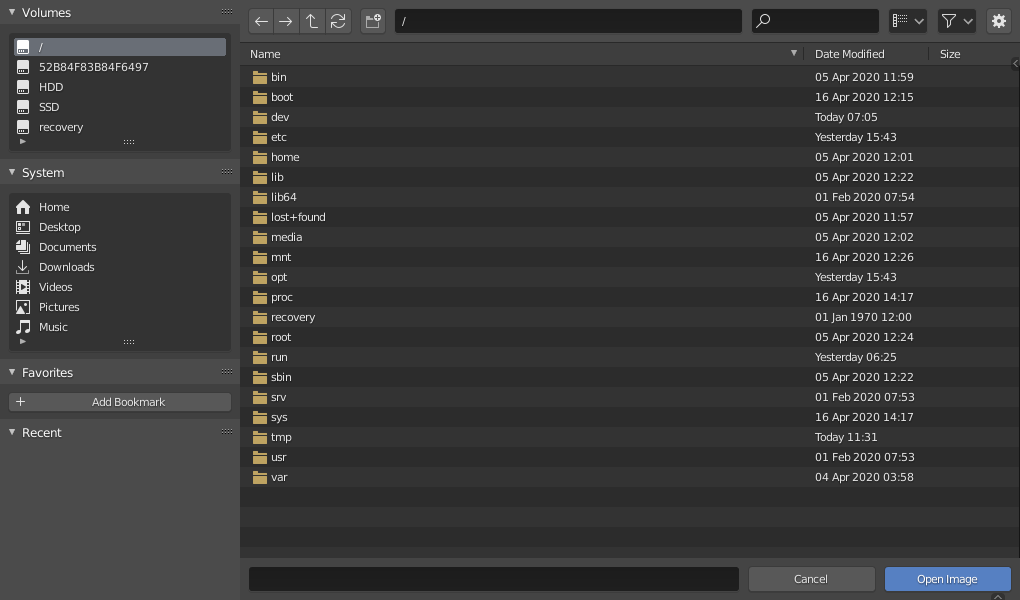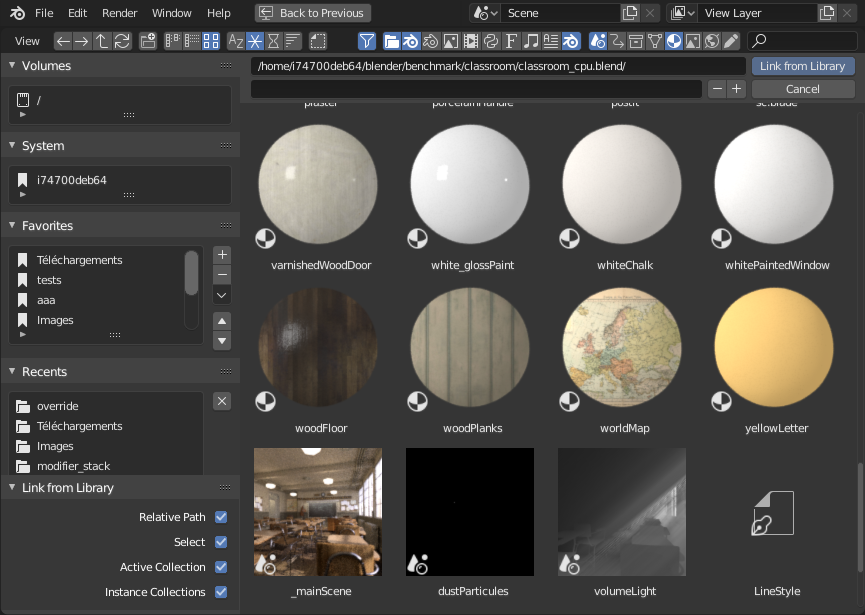Explorador de archivos
The File Browser is used in all the file-related operations. These include:
Apertura y guardado de archivos .blend.
Browsing inside other blend-files, when appending or linking data-blocks, see Linked Libraries.
Importación y exportación desde y hacia otros formatos de archivo.
Picking new locations for existing file paths (images, videos, fonts…).
The most common way to use this editor is through modal operators (like opening or saving a blend-file). The File Browser will appear in a new window, waiting for the operation to complete, and then close returning the main window.
You can use the File Browser as any other editor type, to browse through the file system. The main purpose of this is to be able to drag-and-drop from the File Browser into other editors.
Images into the Vista 3D (to set as background or apply as material texture).
Media files into the Edición de video.

El Explorador de archivos.
Interfaz
Región principal
The main region of the File Browser acts similar to the file browser built into you operating system. The region contains an array of files, folders, or internal blend-file data in a grid or list of items. Navigating, selecting, and editing of these items works just as it would in your operating system’s file browser.
Previsualizaciones
En su modo de visualización Miniatura, el Explorador de archivos ofrece varios tipos de previsualización, que incluyen:
Formatos de imagen y video
Tipografías
Archivos .blend
Bloques de datos internos
In order to get previews for data-block, there previews must be generated. See Blend-files Previews for how to generate and manage Blender data previews.

El modo Miniatura en el Explorador de archivos.
File Path Region
The File Path is above the main region and can aid in navigating and adjust how items are displayed.
- Previous Folder Backspace, Alt-Left
Move to previous folder (in navigation history).
- Next Folder Shift-Backspace, Alt-Right
Move to next folder (in navigation history).
- Parent File P, Alt-Up
Permitirá ir a la carpeta superior.
- Actualizar lista R, . numérico
Actualizará la lista de archivos en la carpeta actual.
- Create Directory I
Will ask you to confirm and create a new directory inside current one, scroll to it in the main view, and let you enter its name.
- File Path Ctrl-L
Text field for the current folder path. Tab will auto-complete an existing path. If you type a nonexistent directory path, you will be prompted to create that new directory.
- Buscar Ctrl-F
Filter items by name. The wildcard
*will match anything, e.g.bl*erwill match bothblenderandblogger. There is always an implicit wildcard at start and end of the search text, soblenderwill also matchtest_blender_file.blend. This field can also be used to filter some specific file extension (e.g..pngwill list all PNG files).
- Modo de visualización
Controls how files are displayed.
- Lista vertical:
Mostrará archivos y carpetas en una lista vertical.
- Lista horizontal:
Mostrará archivos y carpetas en una lista horizontal.
- Miniaturas:
Mostrará previsualizaciones.
Configuración de visualización
- Tamaño
The size of the thumbnails, or the width of the columns.
- Recursion
La cantidad de niveles de carpetas a ser mostradas a la vez de forma plana.
- Ninguno:
List only the current directory content.
- Archivo .blend:
Listará todo el contenido de un archivo .blend (sólo disponible al vincular o anexar bloques de datos).
- One Levels:
Listará el contenido de todas las sub carpetas, con un nivel de recursividad.
- Dos niveles:
List all subdirectories” content, two level of recursion.
- Tres niveles:
Listará el contenido de todas las sub carpetas, con tres niveles de recursividad.
Consejo
Mostrar varios niveles de carpetas a la vez podrá resultar útil para, p. ej. ver toda una colección de texturas, incluso si estuvieran organizadas en un amplio conjunto de carpetas, para evitar tener cientos de archivos en un único lugar.
In the Append/Link case, showing the content of the whole blend-file will allow you to link different types of data-blocks in a single operation.
Advertencia
The more levels you show at once, the more time it will take to list them all (typically, it will be exponential, showing three levels at once may take three orders of magnitude more time to be fully listed).
- Ordenar por
Ordena los elementos por uno de los cuatro métodos:
- Nombre:
Ordena la lista de archivos alfabéticamente.
- Extensión:
Ordena la lista de archivos por extensión/tipo.
- Fecha de modificación:
Ordenar archivos por tiempo de modificación.
- Tamaño:
Ordenar archivos por tamaño.
Opciones de filtrado
On the right side of the file path are the filtering options. The toggle with the funnel icon controls whether filtering is enabled or not.
- Tipos de archivos
Filtra archivos por categorías, tales como carpetas, archivos .blend, imágenes, etc.
- ID de Blender
Al anexar o vincular, también será posible filtrar por categorías de bloques de datos, tales como escenas, animaciones, materiales, etc.
Región de ejecución
- Nombre de archivo
Text field to edit the file name and extension. When saving, if the background is red, a file with same name already exists in the folder. Tab will auto-complete to existing names in the current directory.
- Increment Filename
-,+ Removes/Decreases or adds/increases a trailing number to your file name (used e.g. to store different versions of a file).
- Increment Filename
- Cancelar Esc
Cancels the file selection (and the underlying operation), and closes the File Browser. Using the Back to Previous button in the Topbar will have the same effect.
- Confirmar Intro
The main button to validate the operation, which defines its name. Double-clicking on a non-directory item will have the same effect.
Source List Region
The left region displays different ways to quickly access some directories. The region is divided into separate panels each containing a UI List of directories. Clicking on one of the directories will immediately navigate to that folder.
Volúmenes
Contains all OS-defined available volumes, e.g. drives or network mounts.
Sistema
Contains OS-defined common directories, like the main user folder…
Marcadores
Contains folders that you want to be able to access often without having to navigate to them in the File Browser. To the right of that list are buttons to perform basic management actions on your bookmarks, e.g. add/remove an entry, move it up or down in the list, etc.
Recientes
Contains recently accessed folders.
The X button to the right allows you to fully erase this list.
Será posible controlar cuántas carpetas aparecen en esta lista mediante el campo numérico Archivos recientes de la sección Guardar y cargar de las Preferencias.
Región de opciones del operador
The right region shows the options of the calling operator. Besides common actions listed below, many import/export add-ons will also expose their options there.
- Abrir, Guardar, Guardar como (archivos .blend)
Ver Apertura y guardado.
- Abrir, Reemplazar, Guardar como (imagen)
- Vincular/Anexar desde biblioteca
Para la opción común:
- Rutas relativas
Ver Rutas relativas.
Encabezado
The header only contains two menus, one with you standard editor View controls and the other to list a few Selecting operators for the sake of discoverability. Often it is hidden as most of the functionality is contained in the regions described previously.
Selección
- Seleccionar
Both LMB and RMB clicks work. Holding Shift will extend the items selection.
- (De)select All A
Toggles selecting all files.
- Arrastre
Al arrastrar con LMB se dibujará un marco de selección.
Nota
You can always select several entries in the File Browser, the last selected one is considered as the active one. If the calling operation expects a single path (like e.g. the main blend-file Open one), it will get that active item’s path, other selected ones will just be ignored.
Teclas de flechas
También es posible seleccionar/deseleccionar archivos «recorriéndolos» mediante el uso de las teclas de flecha:
Just using an arrow key, the next file in the chosen direction will be selected and all others deselected.
Holding down Shift while doing this does not deselect anything so it extends to the selection, plus it allows to deselect files by navigating into a block of already selected ones (minimum two files in sequence).
Holding down Shift-Ctrl further selects/deselects all files in between.
Cuando no se encontraran más elementos, la navegación con las teclas de flechas seleccionará el primer o el último archivo de la carpeta, dependiendo de la dirección de la flecha usada.
If you select a directory and hit Return, you will go into that directory
(and highlighting “parent” .. entry will bring you up one level).
Edición
- Externo
Usará comandos del sistema operativo para realizar una acción con el archivo o carpeta. Es posible que las opciones que se listan a continuación no estén disponibles en todos los sistemas operativos.
- Abrir:
Abrirá el archivo.
- Abrir carpeta:
Abrirá la carpeta.
- Editar:
Editará el archivo.
- Nuevo/a:
Creará un nuevo archivo de este tipo.
- Buscar archivo:
Permitirá buscar archivos de este tipo.
- Mostrar:
Mostrará este archivo.
- Reproducir:
Reproducirá este archivo.
- Examinar:
Examinará este archivo.
- Previsualización:
Previsualizará este archivo.
- Imprimir:
Imprimirá este archivo.
- Instalar:
Instalará este archivo.
- Ejecutar como usuario:
Ejecutará el archivo como un usuario específico.
- Propiedades:
Mostrará las propiedades del sistema operativo para este elemento.
- Buscar en carpeta:
Permitirá buscar elementos en esta carpeta.
- Consola de comandos:
Abrirá una consola de comandos del sistema operativo aquí.
- Delete Files Delete, X
Eliminará los archivos o carpetas actualmente seleccionados moviéndolos a la «Papelera» del sistema operativo.
Tener en cuenta que en Linux, la eliminación de carpetas necesitará que se esté usando KDE o GNOME.
- Renombrar F2
Change the name for the currently selected file or directory.